- Share full article
Advertisement
Supported by

Truffles in Paradise. (And It’s Not Italy.)

By Joji Sakurai
- Nov. 16, 2016
“Go Nero!” Nikola Tarandek, a truffle hunter, urged on his black Labrador, who scratched furiously at the moist soil of Motovun Forest in Croatia. We were in the hinterlands of Istria, a diamond-shaped peninsula that juts into the Adriatic Sea, exploring one of the richest grounds for premium white truffles — long overshadowed in fame but not quality by the truffle mecca of Alba in the Piedmont region of Italy. Nero had caught the scent at the roots of an oak, sending up clumps of dirt as Mr. Tarandek twisted a spade into the black earth.
The commotion yielded only a tiny tuber that wasn’t even worth taking back to town. Other truffles that Nero sniffed out turned up spoiled. But it was just the beginning of the season, and within weeks Mr. Tarandek, who runs a side-business taking visitors on truffle-hunting tours , would be bringing fist-sized truffles home to market.
Truffles are considered an expensive delicacy in some places, but that is not the case here. And while the Istrian truffle is premium grade, its culture is free of the snobbery, intrigue and astronomical prices found in Piedmont or in the Perigord region of France.
It’s as if Istrian truffles have been a well-kept secret, ripe for discovery. And that’s beginning to happen with stronger efforts to promote them. The international food world is starting to take notice, with visits to Istrian truffle country increasing every year.
It may seem surprising that a delicacy associated with Italy and France is found in Croatia’s dense oak forests, but truffles have been hunted here for centuries. Istrian truffles have maintained a low profile largely because those from Alba enjoy such cachet.
And there’s another reason: Croatian truffles have for decades made their way to the Italian market and been sold as Alba truffles. Locals say that has translated into little incentive to make their product famous, since hunters earn so much supplying Italy in a shady trade made possible by Istria’s proximity to Piedmont.
That’s been changing in the last decade. The night before my truffle hunt I was dining at Mondo Tavern in the village of Motovun, which commands spectacular views on a hilltop overlooking the truffle forest.
The owner, Klaudio Ivasic, said locals are awakening to the benefits of keeping truffles at home. Until recent years, Motovun’s tourist season ended in August. As truffle fame has grown, the season is extending through November. “People are coming for the truffles,” Mr. Ivasic said proudly.
For travelers, the attractions of an Istrian truffle tour are plentiful. Istria’s rolling landscapes evoke Tuscany; its beaches are among the Mediterranean’s most beautiful; cliffs are dotted with fairy-tale villages — and a truffle meal won’t burn a hole through your wallet.
At Mondo, a man started shaving a white truffle over my plate of Istrian “fuzi,” short pasta. I expected him to stop after a couple of seconds, but he kept going. A heavenly aroma filled the room. The flakes drifted down until my pasta was buried in a white truffle mantle. This dish, which in Milan would easily cost 40 euros (and in New York or London don’t even think about it), is priced here at a reasonable 155 Croatian kuna, or 20 euros ($22).
Mr. Ivasic, himself a truffle hunter, said the dry summer and rainy September had been ideal for white truffles, and that this season could be the best in a decade, although “truffles are a mystery.” In the morning, Mr. Tarandek was less optimistic, and it was understandable. He had been seeking truffles for two hours, to no avail. “Too early in the season,” he mumbled.
Suddenly Nero started barking frantically by the roots of a poplar. His owner dropped to his knees, cutting at roots so his dog could dig deeper. “Come down close to the hole,” Mr. Tarandek beckoned, “and SMELL!” I was then on hands and knees, sinking my face into a muddy crater — just like a truffle-hunting dog — and a blast of truffle hit my nose. Is this the jackpot? Mr. Tarandek shook his head. “Oh no, it’s a small truffle,” he said, “but a good one.”
He continued cutting at roots to extract the puny but precious truffle — and stopped. A stream of invective poured from his lips. The yellowish fleck he had found poking from the dirt was only the tip of a much larger prize.
“I have destroyed the truffle,” he groaned, displaying the chunk he had broken off. “Ohhhhhh my God. That was sooooo big a truffle!”
Hunters command top dollar only for intact truffles. With one careless flick Mr. Tarandek had lost up to 300 euros. But soon he’d seen the brighter side of things, for this meant truffle season was starting in earnest.
“Lucky day,” he said. “Now I have motivation.”
- Skip to main content
- Keyboard shortcuts for audio player
Croatia's Economy Needs Tourists. It's Now Opening The Doors To Vaccinated Americans

Rob Schmitz

A view of Dubrovnik's old town from atop the ancient city wall. Few people are in the ancient town that's usually packed with tourists in the spring. Rob Schmitz/NPR hide caption
A view of Dubrovnik's old town from atop the ancient city wall. Few people are in the ancient town that's usually packed with tourists in the spring.
SPLIT AND DUBROVNIK, CROATIA — The Croatian immigration agent isn't impressed with my flimsy CDC-issued COVID-19 vaccination card. The paper, filled out in loopy strokes of blue cursive by a pharmacist at a Sam's Club in Houston more than a month earlier, looks easy to forge.
"Your second vaccination date hasn't even occurred yet," the immigration agent says, lifting an eyebrow and pointing to its date: 04-12-2021.
I explain that in the United States, we write the month first, then the day. "Oh!" she shouts with a giggle.
She shows the card to another agent. They snicker at how unprofessional this American vaccination card looks. Then she stamps my passport and welcomes me to Croatia.
The land of beaches and castles is one of the first European countries to open its borders to vaccinated Americans, bypassing the European Union as it mires itself in debate over the ethics and implications of "vaccination passports," still undecided on how to move forward. But for Croatia, the most tourism-dependent country in Europe , opening up quickly is crucial to reviving its pandemic-battered economy.

A man rests at Bacvice Beach in the city of Split. The beach has been retaken by local residents, who enjoy bathing in its shallow waters. Rob Schmitz/NPR hide caption
A man rests at Bacvice Beach in the city of Split. The beach has been retaken by local residents, who enjoy bathing in its shallow waters.
In the Adriatic coastal city of Split, among the catacombs below the 1,700-year-old palace built for the Roman emperor Diocletian, a soccer game is broadcast over a lonely transistor radio, one of the only signs of life. Before the pandemic, these catacombs were filled with thousands of tourists a day, but since the pandemic began, Yusuf Khan has sat here alone, surrounded by polished stone chalices, crucifixes and other souvenirs nobody's buying.
"I've lost 90% of my revenue for the past one year and three months," he says.
Khan, originally from Pakistan, has sold souvenirs at this stand for 20 years. Before the pandemic, he earned around $500 a day. "Now I make around $30," he says with a sad smile.
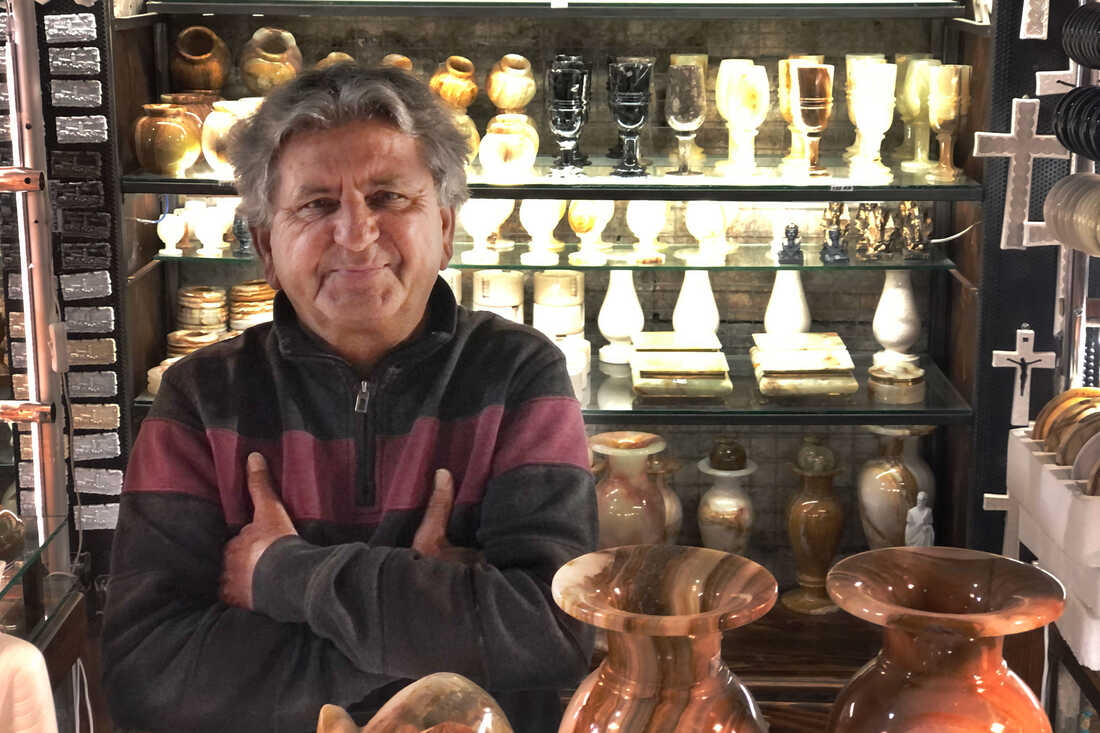
Yusuf Khan at his souvenir stand in the catacombs below Diocletian's Palace, built in the 4th century for the Roman Emperor Diocletian. It later became part of the city of Split. Khan, who has owned his stand for 20 years, typically earns $500 a day, but now says he's lucky if he makes $50. He says he's lost 90% of his business since the pandemic began. Rob Schmitz/NPR hide caption
Yusuf Khan at his souvenir stand in the catacombs below Diocletian's Palace, built in the 4th century for the Roman Emperor Diocletian. It later became part of the city of Split. Khan, who has owned his stand for 20 years, typically earns $500 a day, but now says he's lucky if he makes $50. He says he's lost 90% of his business since the pandemic began.
The Croatian government has helped him with monthly pandemic relief payments, but Split Tourist Board Director Josko Stella admits it's not enough. What's worse, he says, is that in the year leading up to the pandemic, Croatia hosted a record number of tourists.
"We were hoping for 2020 to be the best year of all years because we [would] have Americans coming back, we have the U.K. coming back, we have Chinese coming in, we have Koreans coming in," says an exasperated Stella. "I have been in [the] New York Times Square travel show for two years in a row! Everybody was crazy about Croatia and then, bomb!"
Split went from 18 million overnight stays to just 8 million in a single tourism season. Nationwide, it was far worse — an 86% hit on overnight stays between 2019 and 2020 for a country that usually depends on tourism for more than a fifth of its GDP. According to the National Tourism Board, Croatia had more than 400 million overnight stays in 2019. Last year, the number plummeted to 54 million.

The promenade in the coastal Croatian city of Split, typically filled with tourists from all over the world, is empty as the country tries to open up to tourists again. Rob Schmitz/NPR hide caption
The promenade in the coastal Croatian city of Split, typically filled with tourists from all over the world, is empty as the country tries to open up to tourists again.
Stella says opening the country to the vaccinated is a step in the right direction. He's crossing his fingers for this summer. "Because we can endure one year, we can do two half-years, but three, nobody can endure," he says. "It's crucial this summer, because people will lose hope if this summer they don't go on vacation."
The few tourists who have made it here, like Yuri Merkulov and Carina Kumina, honeymooners from Russia, enjoy empty beaches and vacant Roman ruins.
"It's [a] very, very good time to be here, actually," Merkulov says.

A shopping street in the city of Split is devoid of tourists. Rob Schmitz/NPR hide caption
A shopping street in the city of Split is devoid of tourists.
"Yes, you can take pictures of every place of interest you want and there won't be any people there and you can walk freely and you can see the locals," Kumina chimes in.
Local residents have had their hometowns to themselves for the first time in years. Hundreds of miles down the coast, inside the ancient walled city of Dubrovnik , life has returned to a quiet, pre-tourism existence. The narrow, winding alleys — typically filled with the din of thousands of tourists this time of year — are empty, filled instead with the sounds of a community: a child practicing the piano, a television left on, neighbors chatting.

Dubrovnik's city wall is the biggest tourist draw to the city, especially for Game of Thrones fans, as many scenes were filmed atop the wall. But since the pandemic began, the wall has been largely empty. Rob Schmitz/NPR hide caption
Dubrovnik's city wall is the biggest tourist draw to the city, especially for Game of Thrones fans, as many scenes were filmed atop the wall. But since the pandemic began, the wall has been largely empty.
The old city wall perched atop the rocky shores of the Adriatic — scenery that figured in the HBO series Game of Thrones , where it was portrayed as King's Landing — is usually a big draw. In the high season, the wall is so packed that it sometimes takes hours to enter.
On the day I visit, there are just a handful of tourists in my two-hour walk along the wall. When I'm ready to get off it, it's so empty that I need to find someone with keys to unlock a gate to let me back into the city.
"It's maybe 5% or 6% of the normal season," says the gatekeeper, as he searches in his pockets for the right key. "Two days ago on the wall, it was 200 tickets sold. In 2019, it was 5,000 a day."
After opening the gate, he peppers me with questions about how I was able to travel to Croatia, if I was vaccinated and whether I was scared about the mRNA vaccination altering my DNA permanently.
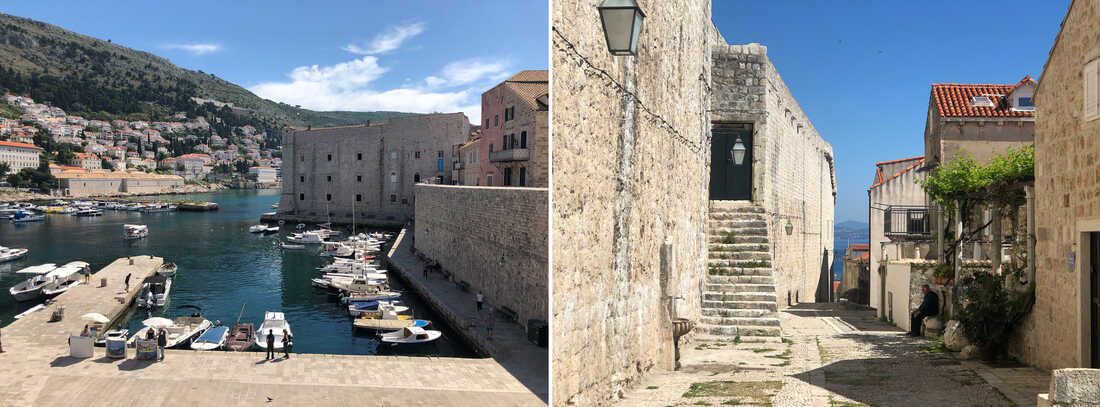
Left: Dubrovnik's tiny port is usually a bustling center of sailboat traffic, all catering to tourists. Right: Inside the city walls of old Dubrovnik. Rob Schmitz/NPR hide caption
Left: Dubrovnik's tiny port is usually a bustling center of sailboat traffic, all catering to tourists. Right: Inside the city walls of old Dubrovnik.
"The city has offered all of us employees the vaccination, but I'm not sure yet," he says.
Barista Petra Ercegovic, who works in Dubrovnik's old town, can't wait to get back to her real job on one of the several cruise ships that, before the pandemic, arrived daily to the city.
"In that glorious year of 2019, when the pandemic was not on our horizon, the city was overcrowded," she remembers. "The cruise ships were coming constantly every single day. The airport is very close by. Every seven minutes when one plane was taking off, and every 10 minutes one was landing."
The plaza where she spends her days serving the few who show up to drink coffee is typically filled with a dozen or more tour groups taking photos of the centuries-old church. Now it has returned to Dubrovnik's residents, including children playing a pickup soccer game against the wall of the 18th century Church of Saint Blaise.
Ercegovic grew up surrounded by tourists in the early 2000s, and she says that until the pandemic, she'd never seen local children play here before. She had only heard stories of it.
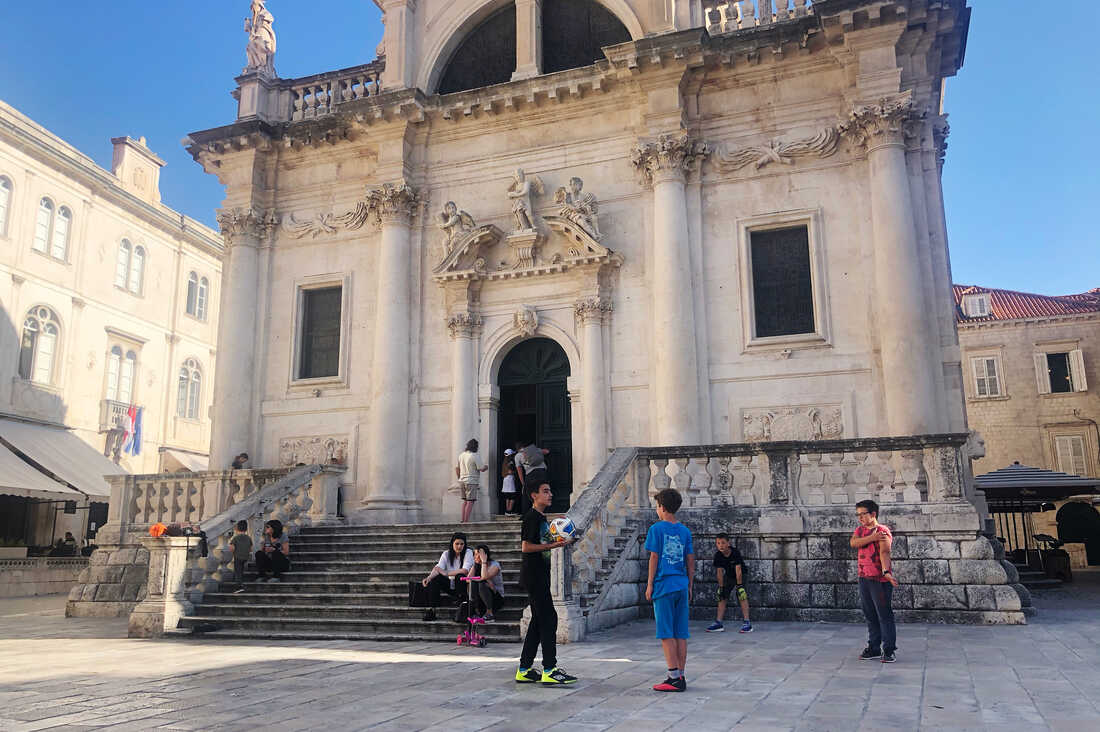
As the city suffers its worst tourism year on record, Dubrovnik has returned to its residents, like these young boys who play a pickup game of soccer outside the Church of Saint Blaise in what's typically one of the busiest squares in the old town. Rob Schmitz/NPR hide caption
As the city suffers its worst tourism year on record, Dubrovnik has returned to its residents, like these young boys who play a pickup game of soccer outside the Church of Saint Blaise in what's typically one of the busiest squares in the old town.
"I remember my father telling me and then my grandpa even showed me the old photos and in front of the old church with him playing with other kids," she says. "So it was really weird that after so many years, I can see kids here now. And it's kind of nostalgic and it's very nice to see them."
Now business is about to pick up. Spurred by Croatia's opening to Americans with vaccination cards, both United and Delta airlines are restarting direct flights from U.S. cities to Dubrovnik in July. Ercegovic's cruise ship line has called her to return to work in September.
In the meantime, Dubrovnik's residents are taking advantage of the empty city, including enjoying outdoor concerts underneath the stars. The Dubrovnik Symphony Orchestra has invited young musicians from the local high school to perform with them. They typically perform in the Rector's Palace, a 15th century Gothic structure known for its superb acoustics — but not in the era of social distancing, says symphony director Damil Milat.
"But outside, in front of the Rector's Palace, it's fresh air, so it's possible to be closer at one meter and a half, and also we are trying not to have a big audience," says Milat.
That isn't hard. The presence of very few tourists means the square in front of the palace is taken up by a few dozen well-dressed local parents, socially distanced, phones out, shooting video of their children performing with the orchestra.

Left: Damil Milat is the manager of the Dubrovnik Symphony Orchestra, which has given live performances outdoors for the city's residents during the pandemic. Right: The Dubrovnik Symphony Orchestra invites young performers from the local community to perform with them, with parents in the audience. Rob Schmitz/NPR hide caption
Left: Damil Milat is the manager of the Dubrovnik Symphony Orchestra, which has given live performances outdoors for the city's residents during the pandemic. Right: The Dubrovnik Symphony Orchestra invites young performers from the local community to perform with them, with parents in the audience.
As the musicians play, one of Dubrovnik's ubiquitous alley cats wanders underneath the French horn section, then the violins, before curling up around the leg of a cellist. Nobody in the audience seems to notice — the cats, after all, are local residents, too — and for the moment, everyone here has their ancient walled city all to themselves.

Discover the Magic of Split: New York Times Unveils the Must-Visit Attractions in the Dalmatian Gem within 36 Hours
The esteemed New York Times has dedicated a report to Split, highlighting its most beautiful attractions worth visiting within 36 hours.
In June 2015, the New York Times featured Split in one of their renowned "36 Hours in..." articles, praising the largest Dalmatian city with carefully chosen words. Almost exactly eight years later, the prestigious American (and global) daily newspaper returned to Split and repeated the accolades.
In an extensive report, the reputable New York Times presented Split as a city where the combination of ancient heritage and culinary offerings easily captivates visitors.
Potential visitors were offered a 36-hour travel plan in one of the most beautiful Croatian cities. The report began by emphasizing a visit to the city's largest sandy beach, Bačvice.
Of course, they couldn't miss highlighting picigin, a popular ball game played in shallow water that attracts tourists, as well as recommending a visit to one of the restaurants with the most beautiful terrace, Dvor, just a few minutes' walk away, offering breathtaking views.

The report mentions that in Split, locals typically associate alcohol with wine, rakija, and beer, and only a few cafés offer cocktails. The ideal way to end the day, according to the New York Times, is to visit the Vidilica on Marjan Hill, which offers a mesmerizing view of the entire city and the surrounding islands, especially during a spectacular sunset.
The following day, tourists are advised to enjoy one of the numerous cafés on the Riva promenade and visit the main market and fish market, known as the "Pazar" and "Peškarija."
The highlight of a visit to Split is exploring the over 1,700-year-old Diocletian's Palace, where the Cellars, Peristyle, and numerous small streets provide a unique encounter with the authentic ancient atmosphere and the spirit of old Rome.

"Step out through the Golden Gate and admire the statue of medieval bishop Grgur Ninski , sculpted by the famous Croatian artist Ivan Meštrović. If you want to continue enjoying art, visit the nearby Gallery of Fine Arts. The next day, you can enhance your experience by visiting Meštrović's gallery, which is a bit further away and surrounded by the beautiful Marjan Park Forest," writes the New York Times.
In addition to describing a range of restaurants, taverns, cafés, and local shops worth visiting, the report also highlights shorter trips to the medieval fortress of Klis, located between the Kozjak and Mosor mountains, and a visit to the remains of the ancient city of Salona.
The Voice of Dubrovnik

Find us on Facebook
Accessibility Links

Croatia guide
When to go, what to do, and why you’ll love it.

M ore than 1,000 miles of coastline, 1,244 islands, ten Unesco world heritage sites and eight national parks. These are just a few of the reasons to love Croatia — the exact moment you’ll fall head over heels may be a little harder to quantify. Perhaps it’ll be the meal of sardines grilled in a little olive oil and enjoyed at a harbourside taverna in one of the many seaside towns that dot the Adriatic coast. Maybe it’ll be the afternoon you spent wandering the knotted maze of streets in a medieval hill town and chancing upon that ramshackle little bar, where the locals welcomed you in with a glass of Croatian wine. Or the long, lazy day you went island-hopping along the Dalmatian coast, stopping to jump into emerald waters and explore hidden coves. The only certainty is that, whichever part of Croatia you fall for, it’ll be the start of a life-long love affair.
This article contains affiliate links, which may earn us revenue .
All trips should include the medieval town of Dubrovnik , the so-called “pearl of the Adriatic”. Get your bearings with a walk around the city walls encircling its ancient heart before diving in and exploring its labyrinth of marble-paved streets.
The Dalmatian coast is an excellent choice if you want a bit of everything: cocktail-fuelled beach parties on Hvar; hiking on Brač; wine and olive oil-making on Korčula; peace and quiet on Vis; and the natural wonders of a national park on Mljet. Small coves lapped by turquoise water, historical stone villages and excellent cooking, from fish stew to slow-cooked lamb, are givens across the archipelago.
Once you’ve had your fill of the coast, head inland to discover a different side to the country: Krka National Park and, further north, Plitvice Lakes National Park — home to a network of sapphire pools and tumbling waterfalls accessed by walking trails. If you’re reluctant to pull off your hiking boots, continue north to another national park, Paklenica, a wild corner of the country with deep gorges and limestone mountains to tackle. You’re unlikely to see them, but knowing that wolves, bears and lynx stalk the park only adds to its allure. Finish in Zagreb, Croatia’s thoroughly modern capital made up of art galleries, rooftop bars, coffee roasteries and street markets built upon Roman foundations.
Advertisement
• Best things to do in Croatia • Best luxury Croatia cruises
Where to stay
The choice of accommodation is pretty endless here, from atmospheric old villas where your alarm clock is the call of the village rooster to modern seaside resorts with infinity pools and wellness centres. Whichever you choose, be sure to book well in advance if you travel to Croatia in the high season. Up until fairly recently, the most characterful places to stay in the country were to be found in private accommodation, with owners renting out apartments or rooms in their family homes. These still exist, and can be a great way to experience local hospitality. On the coast this can mean scoring a charming room in a seafront property, where you can fling open your window shutters and fall asleep to the sound of the waves washing against the harbour walls.
Private accommodation has now been joined by boutique hotels, many converted from heritage properties — giving you all the facilities you’d hope for alongside a bit of architectural history in the form of exposed stone walls, ceiling beams and flagstone floors. Don’t miss the chance to stay in a boutique hotel on a winery, with your bed only a few steps away from the vines. Croatia can do glitz too, in modish hotels such as the Riva in Hvar Town, with Hollywood-themed rooms opening out to views of the super-yachts in the marina. Or take to the water yourself, with many of the major cruise lines offering Adriatic adventures.
• Best luxury villas in Croatia • Best hotels in Dubrovnik • Best hotels in Split
The spotlight in Croatia falls most often on its intricate coastline and stand-out national parks — but there are quieter corners and simpler pleasures to experience in the northwest of the country, in the province of Istria.
Bordering Slovenia, this is a land of gentle beauty, where mists swirl round ancient hilltop towns, and olive trees and vines cloak terraced fields that have been tended to by the same families for generations. Local produce will be a highlight for you here, from silky olive oils to truffles foraged from oak forests, salty sheep’s cheese and wine from indigenous grapes.
Find yourself a spot on a shady terrace outside a family-run konopo (pub), call into a winery for a tasting, or sit by the fire in a dark old tavern and feast to your heart’s content. There are ample opportunities to get your hands dirty if you come in autumn too, with the chance to join the hunt for the region’s prized white truffles. You could spend several days tracing the narrow winding roads round Istria, meandering from one medieval hilltop settlement to another. Three to aim for are Motovun, an unbelievably handsome 14th-century town that curls up a hill above the Mirna River Valley, Grožnjan, home to artists’ studios and a lively summer calendar of cultural events, and sleepy little Oprtalj, a tumbledown village of cobbled streets and ancient stone houses.
Best time to visit
May and September are good bets, with great weather, but fewer crowds than July and August. The mild autumns are perfect for visiting the forested north of the country.
• Best time to visit Croatia
What’s the most beautiful part of Croatia? For all-round appeal it’s hard to beat the Dalmatian coast. Korčula is a good example of what you’ll find here — the island has sheltered bays lapped by turquoise waters, a walled medieval main town with narrow streets paved in marble, and an interior carpeted in pine trees, vineyards and olive groves.
Is Croatia expensive to visit? It can be if you stick to the main tourist centres in high season. It’s easy enough to save money by visiting in shoulder season, spending most of your time in less touristy regions and opting for small, family-run restaurants and guesthouses.
How many days in Croatia is enough? You could visit Dubrovnik and squeeze in a stay on one its islands over a long weekend. To get a proper taste for the country, though, you’ll want at least a week. This will allow you to take in one or two of its fine towns and island-hop along the coast. Increase your stay to ten days and you’ll have time to explore the hilly interior.
Currency Croatian Kuna
Take me there
Inspired to visit Croatia but yet to book your trip? Here are the best packages from Tui and Jet2 Holidays . These are the best tours of Croatia from our trusted partners .
Sign up for the Times Travel Newsletter here .
The New York Times
In transit | q&a: day trips from istria, croatia, q&a: day trips from istria, croatia.
I’m taking a solo trip to Croatia the first week in September and would like some tips on day trips from Istria. One trip offered at my resort is to Venice, but what else would you recommend?
Dusty Rhodes Haverty, Marietta, Ga.

With only a week in Istria why would you want to leave the peninsula? There’s so much to explore on what some consider the Tuscany of Croatia . On the Istria travel guide of nytimes.com/travel , you will find an article by Nathaniel Vinton on seeing the former stomping grounds of the Romans, Hapsburgs and Napoleon from behind handlebars, titled “ Coastal Croatia by Bicycle: Sea, Sun, Truffles ” (May 6, 2007). You can also eat your way through the region with Gisela Williams ’s “ For Foodies, the Next Tuscany ” (Jan. 22, 2006) and Kabir Chibber ’s restaurant review of Mondo Konoba (Feb. 1, 2009) in the town of Motovun.
Other destinations in easy reach include Croatia’s capital, Zagreb , and Slovenia ’s capital, Ljubljana . Zagreb made Ms. Williams’s list of worthy “second-tier” cities to visit in “ Who Needs Venice When Zagreb (or Bruges …) Beckons? ” (April 22, 2007), and you’ll find a long list of great shopping , dining and night-life options in Alex Crevar ’s “ Going to: Zagreb ” (May 1, 2005). Ljubljana is a beautiful, compact city with great museums, parks, walks, markets and outdoor cafes, as chronicled by Mr. Crevar in “ Ljubljana: the Old Europe and the New, Still in Balance ” (July 31, 2005).
Comments are no longer being accepted.
A great day activity within Istria is also the Brioni Islands – national park, animals, Tito museum, dinosaur prints, Roman ruins and a golf course or two as well ! //mykugelhopf.ch/2009/06/brioni-islands/
Another obvious answer is Trieste, Italy, being extremely close, on the cusp of Istria itself, with lots of transportation links. Trieste can seem a hard nut to crack even to other Italians, but if you’re coming from Croatia, it will make some sense – and once you’re having a panino of prosciutto cotto in crosta at a ‘buffet,’ well…. (Da Pepi, profiled in //travel.nytimes.com/2007/05/20/travel/20Bite.html , is only the tip of the iceberg: Siora Rosa, Rudy, Al Rebechin, L’Approdo….)
Also, in Istria itself, don’t overlook the local producers of olive oil, like Ipša, made from the spicy bjelica variety ( //ipsa-maslinovaulja.hr/ , near Motovun).
I second the NYT review of Mondo Konoba, and also recommend Konoba Morgan, in Buje….
Happy traveling,
Jonathan jonathandtaylor.wordpress.com
Depending on where your resort is, travel outside of the peninsula can be difficult. The train system was built to run only north-south because that’s the way the Hapsburgers went to the sea.
Within the peninsula are worthy attractions such as Motovun (a gorgeous location in a valley), Pula (a Roman arena), Rovinj (a seacoast resort), Opatija (the Austrian Riviera), Brijuni National Park (Tito’ s residence), and Porec (a basilica). If you take one side trip outside the peninsula, you should visit one of the world’s most beautiful national parks: Plitvice Lakes. It can be reached by bus.
Concerning Istria, I recommend taking the old road over Ucka Mountain, which lords over the town of Opatija, rather than taking the 5 km tunnel (if your not in a rush). The road is winding and at times steep. You can drive over the mountain and stop at Poklon which has a great view of Rijeka and Kvarner Bay. If you’re more adverturous, take the car to the summit (called Vojak – the road up is just outside Poklon) – the road is paved, but very narrow, but the view from the almost 1400 meter summit is just great.
There is a great restaurant near Poklon called Dopolavore which serves, among other things, game, but it doesn”t seem to be opened all the time so you need to call in advance.
I also recommend checking out the towns in and around Opatija for some great restaurants. In Kastav, check out Kukuriku (also with a great view of Opatija). In Opatija, Bevanda. In Moscenicka draga, Johnson and Nostromo (I haven’t eaten at the latter but hear its a good find).
I recommend getting palacinke for desert wherever you are – ask for it with Nutella (make sure they tell you it’s Nutella and not chocolate – it’s not the same thing as by “chocolate” they mean syrup).
I also suggest getting prsut (proscutto) and cheese as an appetizer.
For main courses, try njoki (gnocchi) or surlice. My favorite is with wild game stew. Many restaurants in Istria often serve them with truffles as well.
If you go to Trieste, make sure you take the local road linking Rijeka-Trieste or one of the other local roads. If you take a highway in Slovenia, you have to buy a 3 month vinette or pass which will set you back 35 Euros. For most tourists, it is a rip off which many believe was enacted last year as a way for Slovenia to grab some of the money of tourists passing thru the country on the way to Croatia. If you go to Ljubljana, you’ll need the vinette.
Outside Istria, I think Zagreb is too far of a hike – it’s about a 2 hour drive from Rijeka, with another hour or so on top of that if you’re coming from the Western Istrian coast. Plus parking can be a headache. If you go to Zagreb, the toll from Rijeka is around 56 or 60 kune in one direction (or around $11-$12). You’ll also need 28 kune (or around $5.50) for the Ucka tunnel in each direction.
You may want to check out some islands – Cres is linked to Istria by ferry, or you can go to Krk via a bridge linked to the mainland (the bridge toll is around 25 kune roundtrip). On Krk, recommended towns are Vrbnik (for its old town and vineyards – I recommend the restaurant Nada – ( //www.vrbnik-krk.at/vrbnik-krk-croatia.htm ) and Baska (for its 2km + long beach).
As a final note, concerning travel within Istria, there is technically no highway in Istria but a fast motor road which is called the Ypsilon do to its shape like a Y. It is currently being expanded into 4 lanes but right now is generally just a 2 lane road. Be careful driving on it – it has earned the nickname “highway of death” by Croatian journalists due to the numerous accidents that happen – often cause by people trying to pass slower moving traffic.
John Kraljic
We returned June 4 from a cruise from Bucharest-this was a continuation of our cruise from Amsterdam to Bucharest. We were on a sister ship and a marrried couple we knew from before were there. He’s a waiter and she a bartender. The restaurant manager, Tibo, a Bulgarian we predict will take over the whole line some day-he agrees. I bought a beautiful blouse in the Central market from a young attractive gal who learned English from TV and was far more fluent than most of the people on the ship. Ivanka managled English with her word order and her information. It was going to be cold bring warm stuff. My husband stuffed our warm stuff in his bag and as we were walking out the door we learned it was probably going to be 89. Lots more and I’lle come back tomorrow if it is still up.
I would suggest the obvious…walking the old town of Rovinj, climbing up the tower to get a great view of the panorama. Pula, the amplitheatre, old town, nearby Brioni island. I also like Umag – the swimming there is great. Do not forget the interior, cities such as Pazin and Labin are quaint with much historical value. As for Ucka, go to the park and spend some time hiking. If you go up through the road that passes Cepic and Boljun you will get to the Ucka tunnel but before you do, take the turn up to the park.
I would venture to Opatija but go on the old road and stop at Vidikovac and take in the panoramic view. On the eastern coast, try swimming at Sveta Marina or Rabac.
The northen interior, such as Hum, Roc, etc near Buzet should also be seen, though I have yet to do so (just never seems to be enough time to see everything).
As for excursions, I would go to Krk, Trieste, Venice but certainly not all of them. Postojnska Jama or Plitvice are outside the region (Postojna is in Slovenia and Plitvice is in the Lika region of Croatia) but they are natural beauties.
But I agree, limit the excursions – you do not have a lot of time in Istria.
If you’ve never seen a Roman ampitheatre, there is a fine one in Pula, on the Istrian Peninsula.
Western Slovenia. For a day trip, Lake Bled. With an overnight stay, add the Soca river valley and Postojna cave.
#4, a correction, the shortest period vignette (toll sticker which you place on the windshield) available is a 7-day sticker for which one needs to pay only 15 euros, not 35, so it is not as expensive, especially if going on a day-trip to Ljubljana (around 130 kms or so from Istria).
I heartily second the recommendation of Rovinj…it’s a gorgeous Venetian-style coastal town (once part of the Venetian Empire). Worth an overnight. Also Piran, another Venetian-style town just across the border in Slovenia’s tiny strip of coastline. I’d skip Trieste, which was a major disappointment–seedy and faded, and not in a good way.
Probably too far for a daytrip (unless well-organized), but an enchanted place for an overnight, is Plitvice National Park.
You should definitely stay in Istria, if you only will be there for one week. It’s one of the most interesting regions in Europe and there are many, many things to discover and see. I’m currently on vacation in Porec / Istria… … travel to Rovinj, Porec, Pula, Opatija,… Istria is one of the most beautiful places is Europe (if you don’t go there during high season)
All the best, Birgit
If you’d like a change of landscape I would suggest to visit Bled, a small mountain village in Slovenia which is so beautiful that it seems a postcard. However, it might be not so near, depending from where you’re going to stay in Croatia.
Plitvice National Park is gorgeous and well worth a visit, though again it could be somewhat too far.
Croatia and the Istrian peninsula are anyway beautiful, especially the small cities on the sea like Rovinj, Porec etc.
I would also not discard the option to visit Trieste. The city is very nice, especially in this time of the year (winter can be awful, with tremendous cold wind (the Bora), and since it is not easy to reach and out of the most travelling itineraries, only few people are visiting it.
I’m sure that you’ll enjoy your trip. There a olot to choose among the great number of excellent suggestions that I’ve read.
//exxxplorer.wordpress.com/
I second the suggestions to see Opatija (Abbazia), Rovinj (Rovigno), the Brioni Islands, and, smaller places in Istria like Motovun or Mosceniga Draga. While I have a fondness for Rijeka, there is not that much to see other than Trsat castle. A good suggestion is Pula to see the Roman arena there but Rovinj is better.
There are plenty of beaches and coves to go swimming in the clear blue of the Kvarner. Try the seafood there as well as the country fare suggested above, it’s marvelous.
Trieste (and Zagreb) may be too far for day trips from Istria, although Venice is doable via sea.
If I were in Istria where there is so much to see and do, I would definitely not go to Venice. Its basically adult Disneyland without the rides but with all the lines and tourists. On the peninsula, my favorite towns were Pula (where you can swim off the rocks in the amazingly clear blue water of the Adriatic and eat the freshest seafood of your life) and Motovun (a city built upon a hill which has a international film festival every year and amazing views of the countryside). Good luck on your week adventure in Istria. Its one of my favorite places on earth!
On Brijuni there is a ruin of a Roman villa, surrounding a placid inlet from the Adriatic, beautiful and likely deserted. Swim there. You will never forget it.
Stay in Istria!
My favorite if I could only go to one place is Groznjan.
Besides a fairy-tale setting on top of a hill, it’s home to an artist colony of sorts. It is just beautiful.
Here’s a little more info: //www.adria24.com/en/travel-guide/istria/groznjan/
Answer to #9 (Mark) related to #4 (John Kraljic) re the Slovenian highway “vinette”:
3 months = 35 euro 7 days = “only 15 euro”
Why should someone pay a 3-month or a 7-day toll to use a country road (highways in Slovenia run east-west for the most part and you are headed north or south) if you are driving through only twice? It’s a rip-off that even the EU has unsuccessfully tried to abolish.
The truth of the matter is that the lines of cars headed to Croatia are so long that made the Slovenes envious and decided to extract a slice out of these tourists’ pockets. Solution: try the local roads — not too bad, have better views and, anyways, Slovenia is so small that you can drive though it in no time. Once crossing the Croatian border, the newly-built highways will be at the German autobahn system standards, and you don’t have to buy “vinettes”, just pay the toll if and when you use them, the way it should be.
I suggest a visit to Krk island. It should not take more than an hour and a half or so to reach Krk from Istria and the old town of Krk is a beautiful place, right at the seaside and fortified with century old walls – definitely worth seeing!
Have a look at some photos here:
//www.aurea-krk.com/towns-krk-croatia.aspx?id=143&name=krk-city
Go to Draguc. Ask the proprietor of the only cafe for the key to the 15th century chapel. One of the most amazing experiences ever.
Re: the vignettes for freeways in Slovenia — Until about a year ago it was pay as you go toll. You stopped periodically and paid, slowing everything down. The 7-day vignette is reasonable for that length of time in the country, and very reasonable compared to some of highway and tunnel tolls charged elsewhere in Europe. The freeways are very good, and fast, and once the Croatian visitor has reached Piran or Koper, then Ljubljana, a very charming place, is about an hour away. Enjoy.
thank you one and all for your comments—I should have stated that I am staying at Koversada and will want to laze about for a few days at least, where breakfast and dinner is included, which doesnt mean that I will not sneak off into Vrsar for dinner once or twice…Piran is one excursion that I would like to look into (Slovenia) and then on to the horse farms, which may prove to be good photo ops…. thank you again—I printed out all comments so far—have 1 week left if there are any local events I should look out for—I have seen info about a sculpture exhibition of students while I am there which sounds cool (in a quarry!!) also some guitar concerts in Vrsar….
Thanks to Mark (#9) for the info re the 7 day vinette – though I agree with Andrew that it is a rip-off for tourists (especially if you’re just driving from Trieste into Istria/Rijeka – there’s really no need to pay it for such a short drive).
I would note in defense of the Slovenes that friends of mine who live full time in the Istrian region and travel often across the border actually say that the vinette saves them money. So some people benefit – but not tourists!
Piran in Slovenia is well worth a visit . No need to go to Venice as its just as photogenic here. Plus Slovenia is so small you can get to most places within an hour or two.
What's Next
New York Times ranks Dubrovnik among top 11 ‘unrecognizable’ world destinations
- by croatiaweek
- May 20, 2020
- in Entertainment
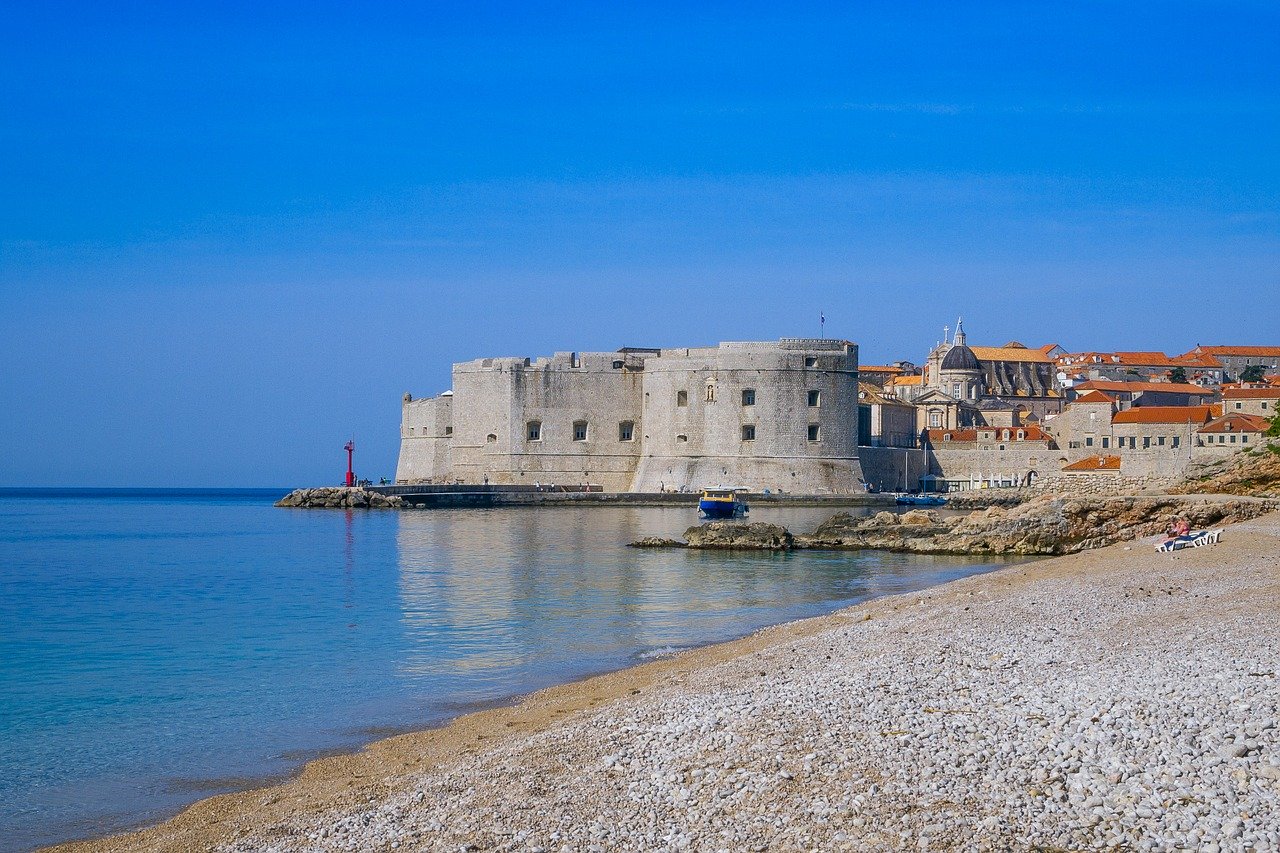
ZAGREB, May 20 (Hina) – The New York Times ranked Dubrovnik among the top 11 world destinations which became quiet places in the midst of the coronavirus pandemic, after struggling with excessive numbers of tourists or with being “overtouristed” before the crisis, Croatia’s National Tourist Board (HTZ) said on Wednesday.
The 11 most visited tourist destinations in the world have lately completely changed so the local population in Venice, for instance, outnumbers the visitors, which is extremely rare for a city which has been struggling with having too many tourists for years, says The New York Times daily, the online edition of which is followed by more than 5 million subscribers.
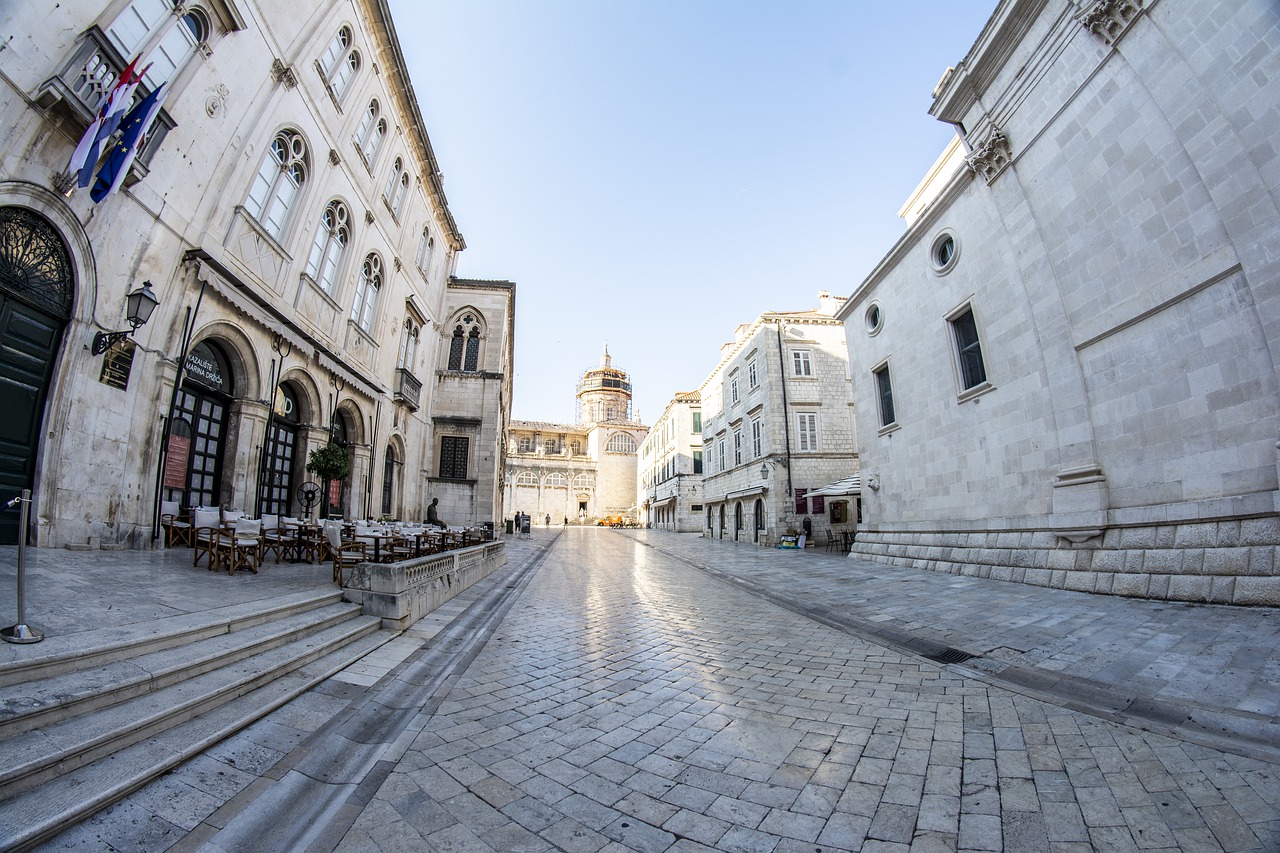
In addition to Dubrovnik and Venice, the list of “unrecognizable” destinations features Rome, Bali, Iceland, Amsterdam, Barcelona, Paris, Prague, Halong Bay in Vietnam and the Galapagos Islands, said Ina Rodin, the director of the HTZ’ New York office.
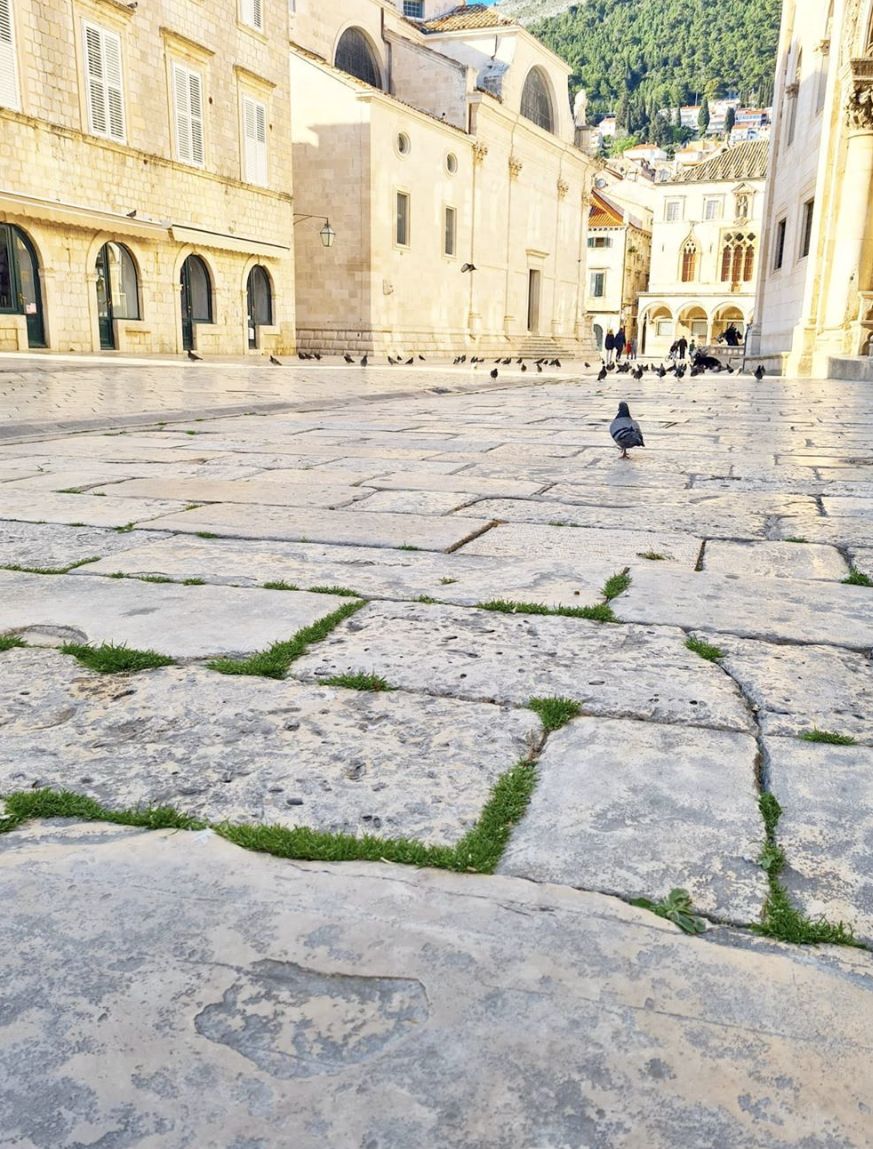
The grass had a chance to grow on the cobbled streets (Photo credit: Lajk Restoran)
The article also includes the experience of locals in those destinations, and the situation in Dubrovnik is described by Darko Perojevic, the chef and owner of the restaurant Azur, who underscored that the Old Town, where he had lived most of his life, had not been empty like this since the war in the 1990s.
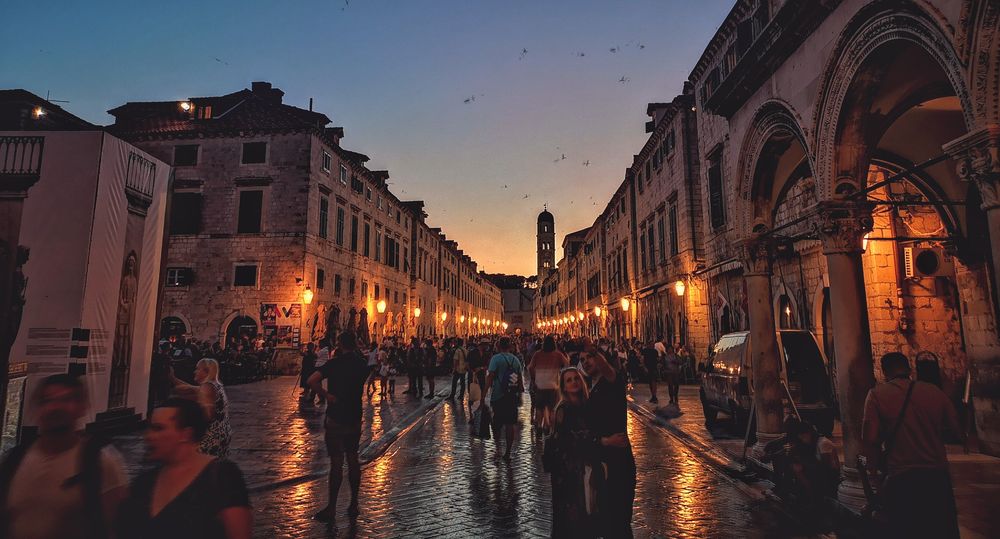
Dubrovnik during the busy time (Photo: Patricia Jekki/Unsplash)
However, he admitted that it was great to walk in the empty city centre and see kids playing on the streets. “For a moment it feels like we got the city back for ourselves,” Perojevic said, adding that the first quarantine in Dubrovnik was introduced in the 14th century to protect the citizens from the black plague.
Sign up to receive the Croatia Week Newsletter
Related posts.

Croatia named host of 2024 European Water Polo Championship
- November 17, 2023
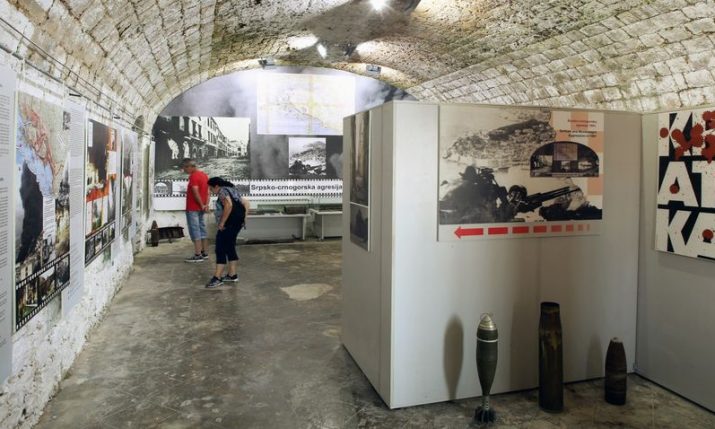
Homeland War Museum Dubrovnik attracting hundreds of thousands of visitors
- December 6, 2023
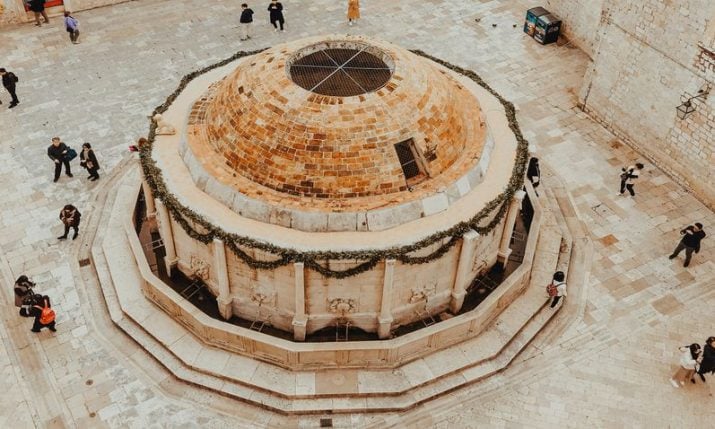

14th century city cistern discovered under Dubrovnik’s famous fountain
- February 15, 2024
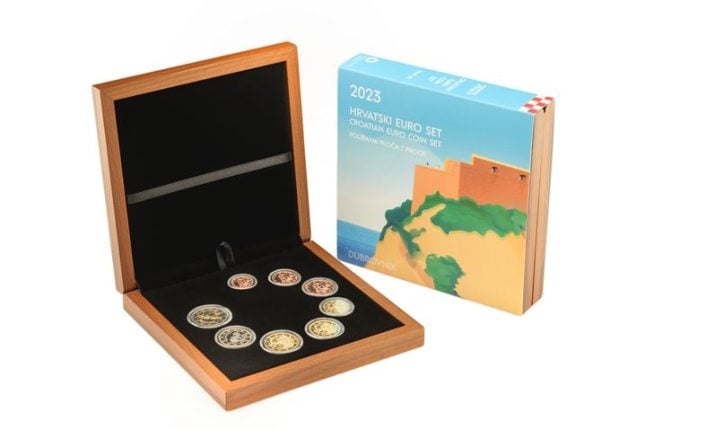
First official Croatian euro coin set – Dubrovnik – is issued
- December 1, 2023
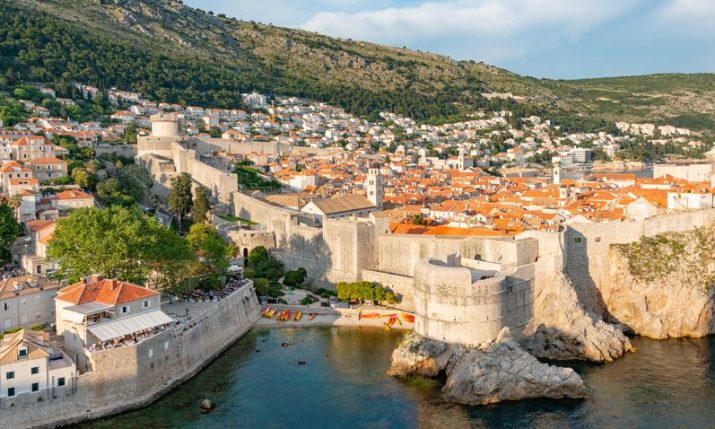
Dubrovnik named must-visit destination in 2024
- January 3, 2024

Dubrovnik opens its first registered animal shelter
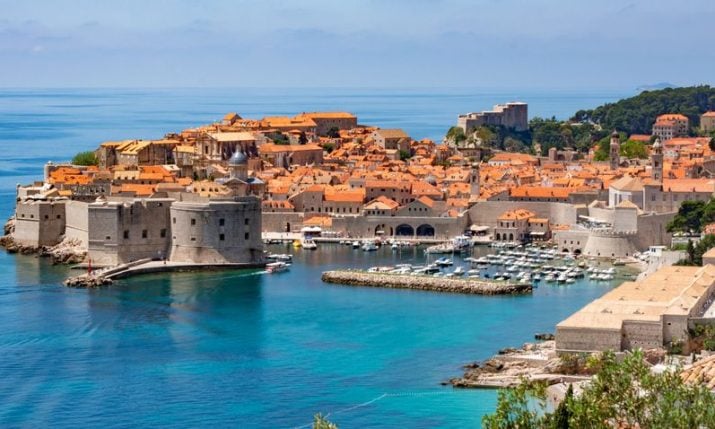
Dubrovnik declared world’s best seaside metropolitan destination
- December 3, 2023
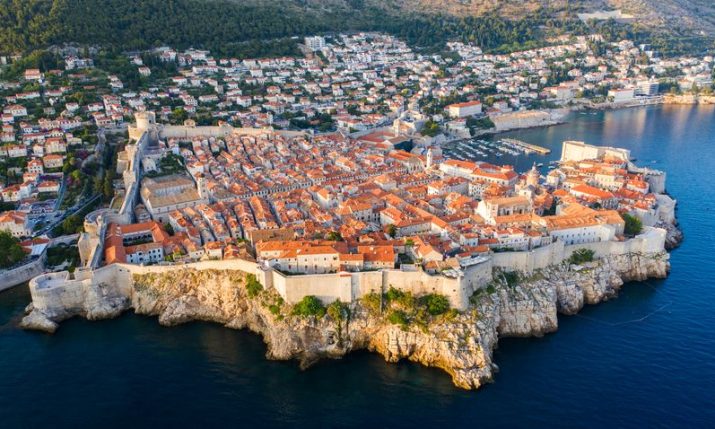
Dubrovnik Airport to surpass 3 million passengers for first time
- April 1, 2024
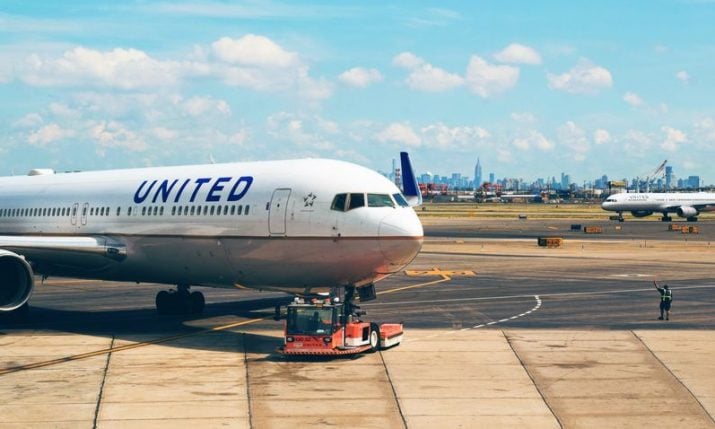
New York and Dubrovnik connected this summer with flights
- March 16, 2024

Croatia Named in New York Times Top 5 Hottest Destinations for Summer
Daniela Rogulj
June 13, 2017
Here we go again…
Summer travel is on the rise in the United States, and the New York Times has shared some rather convincing data on why and where Americans are traveling in their trending travel story titled “ For Summer, Five Hot Destinations ,” published on June 8, 2017.
American Express Travel, a leisure travel network, is up 26 percent on international airfare bookings, and travel networks and companies are recording anywhere between a 10-20 percent increase in bookings for travel this summer. So, what’s going on?
Perhaps Americans are traveling more than they did in 2016 because of the heated presidential election, suggests NYT, but we’re curious, of course, to find out where exactly they’re going this summer.
Sure enough, they’re coming to Croatia – one of five places to make the top five hottest destinations this summer.
NYT reports:
“Indagare has a 30 percent increase in trip bookings to Croatia for travel this summer, compared with summer 2016, and Expedia . com has seen air ticket demand to the country double from last summer. Mr. Alexander of Protravel International said that he has planned several dozen private trips to Croatia for travel this summer — the most he has ever done. The country has a multifaceted appeal as a vacation destination, he said. “The beaches are fantastic, the food is delicious, and there’s culture and history,” he said.
In addition, Mr. Alexander said that many of his clients who are headed to Croatia in the coming months have told him that, at a time when terrorist attacks around the world seem to be increasingly commonplace, Croatia is perceived as being “safe.”
You can find all five hot summer destinations in the full article here .
Subscribe to our newsletter
Related posts:.

Leave a Comment Cancel reply
Save my name, email, and website in this browser for the next time I comment.
most Popular
Most recent.

Business , Lifestyle
Manjgura and prodajni mindset won the huoj grand prix golden award for the conference “the wolf strikes again”.

Blog , Lifestyle
Why i will never again report a crime in croatia.

Spin Casino: Dubrovnik Airport Parking “Most Expensive in Europe”

MUP Introduces New Cameras Along Croatian Motorways

Lifestyle , Zagreb Events
Second asian street food festival coming to zagreb this may.
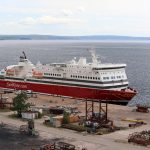
Largest Jadrolinija Vessel Arrives in Croatia
© 2024 Total Croatia NEWS
Subscribe to our Newsletter
the fields marked with * are required

IMAGES
COMMENTS
The redesigned 101-room hotel, on Split's so-called West Bank (the Riva's western extension), has wellness amenities and a rooftop pool with island views. Doubles from €110. The Santa Lucia ...
1) 4:30 p.m. Getting your bearings. Climb 561 steps up Petar Kruzic Stairway to the 13th-century Trsat Castle on a bluff at the edge of the Rjecina River, for which Rijeka is named. Atop the ...
Lodging. Hotel Excelsior Dubrovnik (Frana Supila 12; 385-20-300-300 ; alh.hr; doubles from $550). Reopened in May 2017 after an extensive renovation, the iconic 104-year-old Excelsior has 158 ...
May 25, 2022. A bike ride from Trieste, Italy, through Slovenia, to the ancient city of Pula, Croatia, starts from the Adriatic coast's 90-degree bend on the sea's northern coast and rolls ...
36 Hours in Split, Croatia. 19. Surrounded by mountains and sea, Split has it all: Roman ruins, trendy shops and fashionable restaurants. Max Cantor for The New York Times. By Jennifer Conlin ...
Surrounded by mountains and sea, Split has it all: Roman ruins, trendy shops and fashionable restaurants.Produced by: Fritzie Andrade, Max Cantor, Chris Carm...
Tihomir Cipek, a political science professor at the University of Zagreb, said the result reflected a general trend in Europe, particularly among new members of the European Union, which Croatia ...
News about Croatia, including commentary and archival articles published in The New York Times.
White truffles found by Nero, a Labrador, in Motovun, Croatia. Andy Haslam for The New York Times. The owner, Klaudio Ivasic, said locals are awakening to the benefits of keeping truffles at home ...
Jazzy lounges, bistros and chic ateliers abound in newly popular Zagreb, but this Slavic metropolis still retains plenty of cobbled-street charm.Produced by:...
"I have been in [the] New York Times Square travel show for two years in a row! Everybody was crazy about Croatia and then, bomb!" Split went from 18 million overnight stays to just 8 million in a ...
October 25, 2019 - The New York Times' Alex Crevar reveals all about his 36-hour trip to Rijeka. "If the coastal regions of Croatia have become tourist stars, then Rijeka, a working-class port city in the Adriatic, is grossly underestimated.
In an extensive report, the reputable New York Times presented Split as a city where the combination of ancient heritage and culinary offerings easily captivates visitors. Potential visitors were offered a 36-hour travel plan in one of the most beautiful Croatian cities.
ZAGREB, July 8 (Hina) - The New York Times has put Croatia on a list of countries open for US nationals, as one of the few such destinations in the Mediterranean, the Croatian Tourism Board (HTZ ...
The Delta flights, on Boeing 767-300 aircraft, will run four times a week (Tuesday, and Thursday through Saturday from New York; Wednesday, and Friday through Sunday from Dubrovnik.)
This article contains links from which we may earn revenue. More information here.. More than 1,000 miles of coastline, 1,244 islands, ten Unesco world heritage sites and eight national parks.
Mark August 18, 2009 · 8:05 pm. #4, a correction, the shortest period vignette (toll sticker which you place on the windshield) available is a 7-day sticker for which one needs to pay only 15 euros, not 35, so it is not as expensive, especially if going on a day-trip to Ljubljana (around 130 kms or so from Istria).
January 25, 2020 - The Croatian National Tourist Board (HTZ), which is at the New York Times Travel Show from January 24 to 26, said that Croatia is among the most sought-after tourist destinations, based on the results of market research and the booking announcements by major tourist associations.
The New York Times Travel Show is visited by more than 35,000 visitors with more than 700 exhibitors from 175 countries around the world, making it the largest tourism fair in North America. Tags:
The most visited travel fair on the East Coast of the United States, the New York Times Travel Show was held from January 27 to 29. At the fair this year, there were 500 exhibitors from 150 countries, of which as many as 40% were new exhibitors, reports HRTurizam on January 30, 2017.. Within the Croatian Tourist Board representation in the US was the Zagreb Tourist Board, the City of Dubrovnik ...
ZAGREB, May 20 (Hina) - The New York Times ranked Dubrovnik among the top 11 world destinations which became quiet places in the midst of the coronavirus pandemic, after struggling with excessive ...
And with Croatia's recent adoption of the euro and entrance into a border-free EU area, it's now even easier to swoon over Split's history and ancient ruins. Here's our 36 Hours guide. ... Air Travel Emissions Vastly Outpace Predictions (Published 2019) ... Typos of the New York Times.
Summer travel is on the rise in the United States, and the New York Times has shared some rather convincing data on why and where Americans are traveling in their trending travel story titled "For Summer, Five Hot Destinations," published on June 8, 2017. American Express Travel, a leisure travel network, is up 26 percent on international airfare bookings, and travel networks and companies ...